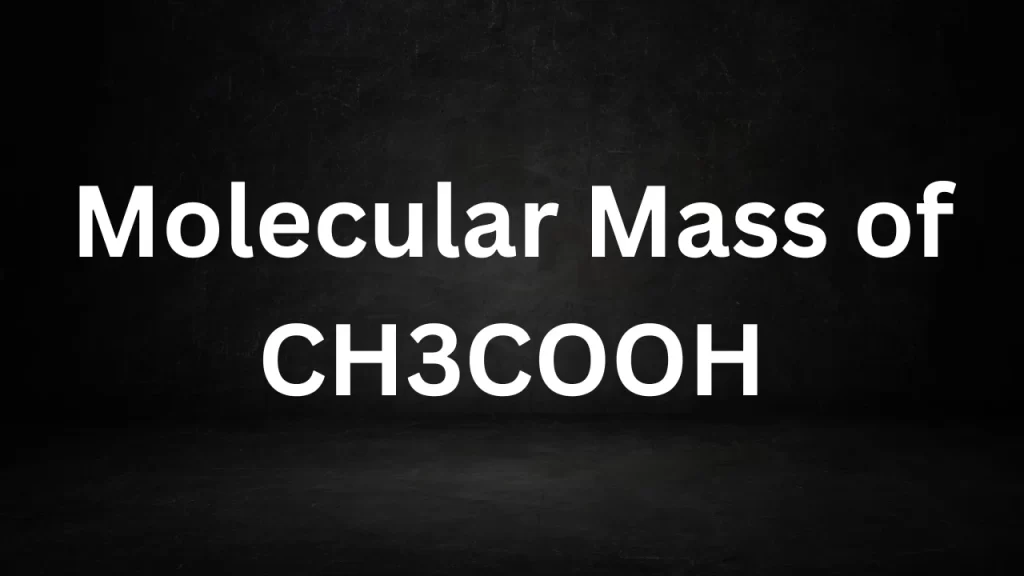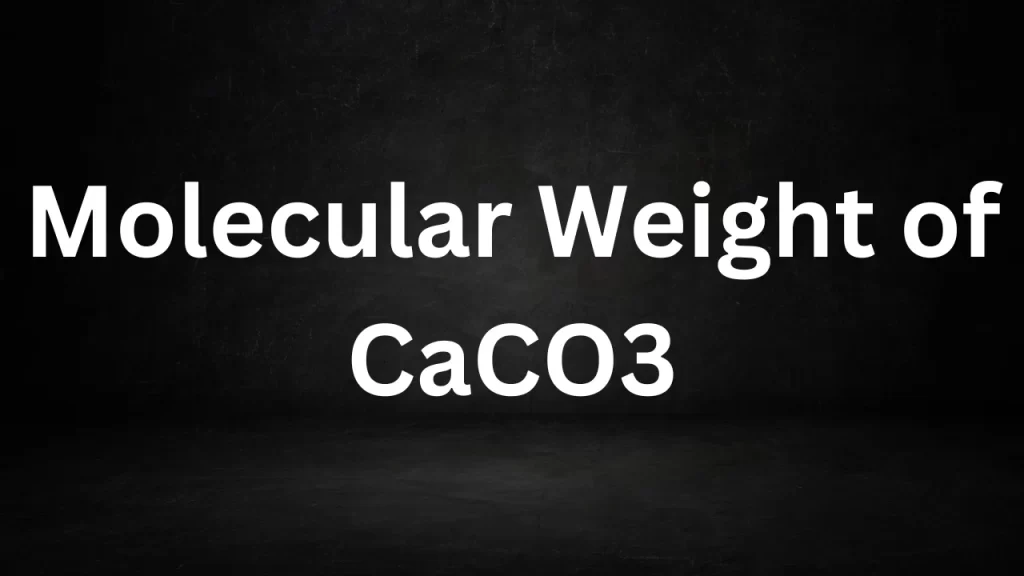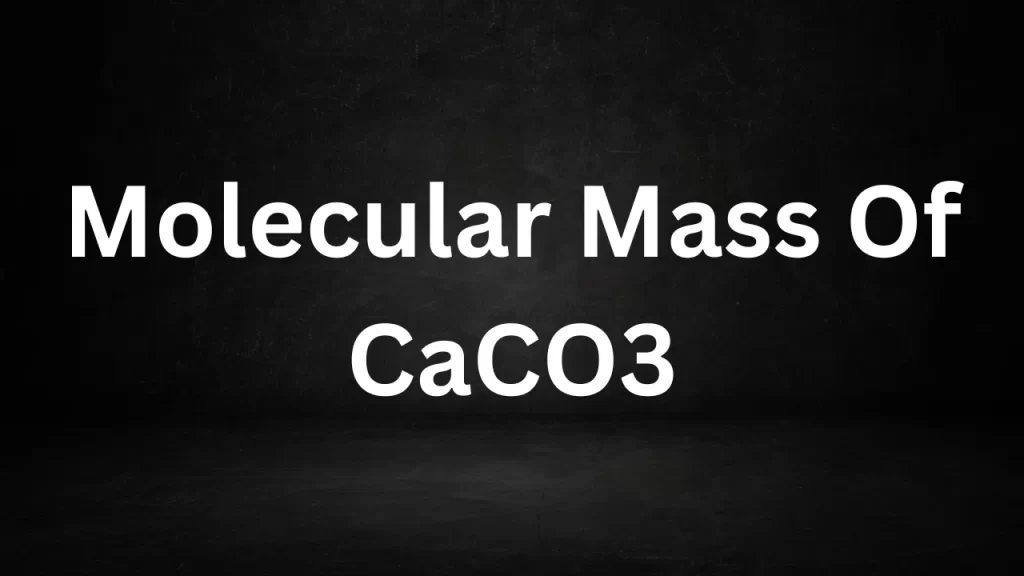Category: Class 9
Molecular Mass of CH3COOH
Molecular Mass of CH3COOH: Chemistry is a science that unveils the intricacies of the universe at the molecular level. A fundamental concept in this realm is molecular mass, also known as molecular weight or molar mass.
It plays a crucial role in understanding the composition and behavior of chemical compounds. In this article, we’ll explore the molecular mass of a familiar substance: acetic acid, represented by the chemical formula CH3COOH.

Molecular Mass of CH3COOH
Acetic Acid (CH3COOH): A Household Chemical with Widespread Utility
Acetic acid, commonly known as vinegar when diluted in water, is a simple organic compound with a distinctive pungent odor and a wide range of applications. It is a crucial component in the food industry for flavoring and preserving, and it has uses in the production of various chemicals, textiles, and plastics.
Calculating the Molecular Mass of CH3COOH
The molecular mass of a compound is determined by adding up the atomic masses of all the atoms in one molecule of that compound. In the case of acetic acid (CH3COOH), we must consider the atomic masses of its constituent elements:
- Carbon (C): The atomic mass of carbon is approximately 12.01 grams/mole (g/mol).
- Hydrogen (H): Hydrogen has an atomic mass of approximately 1.01 g/mol.
- Oxygen (O): The atomic mass of oxygen is around 16.00 g/mol.
Now, let’s perform the calculations:
Molecular Mass of CH3COOH = (Atomic Mass of C) + (2 * Atomic Mass of H) + (2 * Atomic Mass of O)
Molecular Mass of CH3COOH = (12.01 g/mol) + (2 * 1.01 g/mol) + (2 * 16.00 g/mol)
Molecular Mass of CH3COOH = 12.01 g/mol + 2.02 g/mol + 32.00 g/mol
Molecular Mass of CH3COOH ≈ 44.03 grams/mole
Thus, the molecular mass of acetic acid (CH3COOH) is approximately 44.03 grams per mole.
Significance of Molecular Mass
Understanding the molecular mass of a compound is essential in various scientific disciplines and industries. It is fundamental for accurate calculations in chemistry, including stoichiometry and chemical reactions. Molecular mass is used to determine the composition, concentration, and behavior of substances in a variety of applications.
Applications of Acetic Acid (CH3COOH)
Acetic acid finds wide-ranging applications, including:
- Food Industry: It is used as a food preservative and flavor enhancer.
- Chemical Industry: It serves as a precursor for the production of various chemicals, including plastics.
- Pharmaceuticals: It is used in the manufacture of certain medications.
- Textiles: It plays a role in dyeing and finishing textiles.
- Laboratory: It is a common reagent for chemical experiments.
Conclusion
In the captivating realm of chemistry, comprehending the molecular mass of compounds such as acetic acid (CH3COOH) is fundamental. It provides insights into the composition and behavior of substances, enabling precise calculations in chemical reactions and various industrial processes. With a molecular mass of approximately 44.03 g/mol, acetic acid is not only a household staple but also a versatile chemical with a profound impact on both daily life and scientific endeavors. Its ubiquitous presence highlights the significance of chemistry in shaping the world around us.
Read More
- Molecular Weight of kmno4
- Molecular Weight of CaCO3
- Molecular Mass Of CaCO3
- Molecular Mass Of Sulphur
- Equivalent Weight Of Hcl
Frequently Asked Questions (FAQs) mol Mass of CH3COOH
1. What is the molecular mass of CH3COOH?
The molecular mass of acetic acid (CH3COOH) is approximately 44.03 grams per mole (g/mol).
2. How is the mol mass of CH3COOH calculated?
To calculate the mol mass of CH3COOH, you add up the atomic masses of all the atoms in one molecule of CH3COOH:
- Carbon (C): Atomic mass ≈ 12.01 g/mol
- Hydrogen (H): Atomic mass ≈ 1.01 g/mol
- Oxygen (O): Atomic mass ≈ 16.00 g/mol
The calculation is as follows: mol Mass of CH3COOH = (Atomic Mass of C) + (2 * Atomic Mass of H) + (2 * Atomic Mass of O) mol Mass of CH3COOH ≈ 12.01 g/mol + 2.02 g/mol + 32.00 g/mol ≈ 44.03 g/mol
3. Why is it important to know the mol mass of CH3COOH?
Understanding the mol mass of CH3COOH is crucial in various scientific disciplines, particularly in chemistry. It is fundamental for accurate calculations in chemical reactions, stoichiometry, and determining the concentration of solutions. Molecular mass provides insights into the composition and behavior of substances.
4. What are some common uses of CH3COOH in daily life and industry?
Acetic acid (CH3COOH) has diverse applications, including:
- Food industry: It’s used in vinegar for flavoring and preservation.
- Chemical industry: It serves as a precursor for the production of various chemicals and plastics.
- Pharmaceuticals: It’s used in the manufacture of certain medications.
- Textiles: It’s involved in dyeing and finishing textiles.
- Laboratory: It’s a common reagent for chemical experiments.
5. Is CH3COOH safe to handle?
Acetic acid, in its diluted form (vinegar), is generally safe for common household use. However, concentrated acetic acid can be corrosive and should be handled with care, including wearing appropriate protective equipment. Safety precautions should be taken when working with concentrated acetic acid in laboratory or industrial settings.
Molecular Weight of kmno4
Molecular Weight of kmno4: Chemistry is a realm of science that peels back the layers of the universe at the molecular level. At the heart of this scientific discipline lies the concept of molecular weight, a fundamental property used to understand the composition and behavior of chemical compounds.
In this article, we’ll delve into the molecular weight of potassium permanganate, known by its chemical formula as KMnO4.

Molecular Weight of kmno4
Potassium Permanganate (KMnO4): A Versatile Chemical Compound
Potassium permanganate, represented by the chemical formula KMnO4, is a powerful and versatile chemical compound that plays a significant role in various scientific, industrial, and medical applications. Its striking purple color and powerful oxidizing properties have made it a staple in laboratories and industries around the world.
Breaking Down the Molecular Weight of KMnO4
The molecular weight of a compound is determined by summing the atomic weights of all the atoms present in one molecule of that compound. To calculate the molecular weight of KMnO4, we must consider the atomic weights of its constituent elements:
- Potassium (K): The atomic weight of potassium is approximately 39.10 g/mol.
- Manganese (Mn): Manganese has an atomic weight of roughly 54.94 g/mol.
- Oxygen (O): The atomic weight of oxygen is around 16.00 g/mol.
Now, let’s perform the calculations:
Molecular Weight of KMnO4 = (Atomic Weight of K) + (Atomic Weight of Mn) + (4 * Atomic Weight of O)
Molecular Weight of KMnO4 = (39.10 g/mol) + (54.94 g/mol) + (4 * 16.00 g/mol)
Molecular Weight of KMnO4 = 39.10 g/mol + 54.94 g/mol + 64.00 g/mol
Molecular Weight of KMnO4 ≈ 158.04 g/mol
Thus, the molecular weight of potassium permanganate (KMnO4) is approximately 158.04 grams per mole.
The Significance of Molecular Weight
Understanding the molecular weight of a compound is vital in various scientific disciplines and industries. It is a fundamental parameter for precise calculations in chemistry, particularly in stoichiometry and chemical reactions. Molecular weight allows scientists to determine the composition and properties of substances and helps in predicting their behavior in chemical reactions.
Applications of Potassium Permanganate (KMnO4)
Potassium permanganate finds wide-ranging applications, including:
- Water Treatment: It is used to remove impurities and disinfect water.
- Chemical Analysis: In laboratories, it is employed as a strong oxidizing agent for various analytical techniques.
- Medicine: In dermatology, it is used as a topical disinfectant and antiseptic.
- Firefighting: It can be used in the prevention of wildfires.
- Environmental Remediation: It is utilized to treat contaminated soil and groundwater.
Conclusion
In the intricate world of chemistry, comprehending the molecular weight of compounds such as potassium permanganate (KMnO4) is essential. It is the key to understanding the compound’s composition and behavior in various applications. With a molecular weight of approximately 158.04 g/mol, KMnO4 is not only a potent chemical reagent but also a symbol of the profound impact of chemistry on our daily lives. Its versatile properties and applications make it a remarkable substance with a prominent role in science and industry.
Read More
- Molecular Weight of CaCO3
- Molecular Mass Of CaCO3
- Molecular Mass Of Sulphur
- Equivalent Weight Of Hcl
- Equivalent Weight Of Naoh
Frequently Asked Questions (FAQs) mol Weight of kmno4
1. What is the mol weight of KMnO4?
The mol weight of potassium permanganate (KMnO4) is approximately 158.04 grams per mole (g/mol).
2. How is the mol weight of KMnO4 calculated?
To calculate the mol weight of KMnO4, you add up the atomic weights of all the atoms present in one molecule of KMnO4:
- Potassium (K): Atomic weight ≈ 39.10 g/mol
- Manganese (Mn): Atomic weight ≈ 54.94 g/mol
- Oxygen (O): Atomic weight ≈ 16.00 g/mol
The calculation is as follows: mol Weight of KMnO4 = (Atomic Weight of K) + (Atomic Weight of Mn) + (4 * Atomic Weight of O) mol Weight of KMnO4 ≈ 39.10 g/mol + 54.94 g/mol + 64.00 g/mol ≈ 158.04 g/mol
3. Why is it important to know the mol weight of KMnO4?
Understanding the mol weight of KMnO4 is crucial in chemistry and various industries. It allows scientists and chemists to calculate quantities accurately in chemical reactions, determine concentrations, and make precise formulations. Molecular weight is a fundamental parameter for stoichiometry and other chemical calculations.
4. What are some common uses of KMnO4 in practical applications?
Potassium permanganate (KMnO4) has diverse applications, including:
- Water treatment: It’s used for disinfection and oxidation of organic matter.
- Analytical chemistry: It’s employed as a strong oxidizing agent for various chemical tests.
- Medicine: It serves as a topical antiseptic and disinfectant.
- Environmental applications: It’s used to treat contaminated soil and water.
- Firefighting: It can be used as a fire suppressant for some types of fires.
- Chemistry experiments: It’s a common reagent for laboratory work.
5. Is KMnO4 a safe chemical to work with?
While potassium permanganate is generally considered safe when handled properly, it should be treated with care. It can stain skin and clothing and can be an irritant to the eyes and respiratory system. It’s crucial to follow safety guidelines and wear appropriate protective equipment when working with KMnO4.
Molecular Weight of CaCO3
Molecular Weight of CaCO3: Chemistry, often referred to as the central science, unravels the secrets of the universe on a molecular scale. An integral concept in the realm of chemistry is the molecular weight, also known as molecular mass or molar mass.
It is a crucial aspect in understanding and working with compounds. In this article, we delve into the molecular weight of calcium carbonate (CaCO3), a common and versatile chemical compound.

Molecular Weight of CaCO3
Calcium Carbonate (CaCO3): A Versatile Compound
Calcium carbonate, with its chemical formula CaCO3, is a compound that has a profound impact on our daily lives. It occurs naturally in various forms, including limestone, chalk, and marble. Additionally, it is an essential component in shells of marine organisms and serves as a vital mineral in human bones and teeth. Calcium carbonate finds application in a multitude of industries, ranging from construction to medicine and food production.
Breaking Down the Molecular Weight of CaCO3
The molecular weight of a compound is determined by summing the atomic weights of all the atoms present in a single molecule of that compound. In the case of CaCO3, we must consider the atomic weights of its constituent elements:
- Calcium (Ca): The atomic weight of calcium is approximately 40.08 g/mol.
- Carbon (C): Carbon has an atomic weight of roughly 12.01 g/mol.
- Oxygen (O): The atomic weight of oxygen is around 16.00 g/mol.
Now, let’s perform the calculations:
Molecular Weight of CaCO3 = (Atomic Weight of Ca) + (Atomic Weight of C) + (3 * Atomic Weight of O)
Molecular Weight of CaCO3 = (40.08 g/mol) + (12.01 g/mol) + (3 * 16.00 g/mol)
Molecular Weight of CaCO3 = 40.08 g/mol + 12.01 g/mol + 48.00 g/mol
Molecular Weight of CaCO3 ≈ 100.09 g/mol
Thus, the molecular weight of calcium carbonate (CaCO3) is approximately 100.09 grams per mole.
The Significance of Molecular Weight
Understanding the molecular weight of a compound is essential in a wide array of scientific, industrial, and practical contexts. It is fundamental for accurate calculations in chemical reactions, stoichiometry, and formulation of compounds. In laboratory settings, scientists often express quantities of substances in moles rather than grams because moles provide a consistent way to represent the amount of a substance.
Moreover, molecular weight plays a pivotal role in stoichiometry, which is the branch of chemistry concerned with the quantitative relationships between reactants and products in a chemical reaction. This knowledge enables chemists to predict the quantities of products formed from given amounts of reactants.
Conclusion
In the fascinating realm of chemistry, comprehending the molecular weight of compounds such as calcium carbonate (CaCO3) is indispensable. It grants valuable insights into the composition of substances and is pivotal for performing precise calculations in chemical reactions. The molecular weight of CaCO3, approximately 100.09 g/mol, underscores the compound’s importance not only in the world of chemistry but also in various industrial processes and natural phenomena. From construction materials to dietary supplements, calcium carbonate’s multifaceted utility is a testament to its intriguing chemistry and molecular structure.
Read More
- Molecular Mass Of CaCO3
- Molecular Mass Of Sulphur
- Equivalent Weight Of Hcl
- Equivalent Weight Of Naoh
- Molecular Mass Of Hcl
Frequently Asked Questions (FAQs) mol Weight of CaCO3
1. What is the mol weight of CaCO3?
The mol weight of calcium carbonate (CaCO3) is approximately 100.09 grams per mole (g/mol).
2. How is the mol weight of CaCO3 calculated?
To calculate the mol weight of CaCO3, you add up the atomic weights of all the atoms present in one molecule of CaCO3:
- Calcium (Ca): Atomic weight ≈ 40.08 g/mol
- Carbon (C): Atomic weight ≈ 12.01 g/mol
- Oxygen (O): Atomic weight ≈ 16.00 g/mol
The calculation is as follows: mol Weight of CaCO3 = (Atomic Weight of Ca) + (Atomic Weight of C) + (3 * Atomic Weight of O) mol Weight of CaCO3 ≈ 40.08 g/mol + 12.01 g/mol + 48.00 g/mol ≈ 100.09 g/mol
3. Why is it important to know the mol weight of CaCO3?
Understanding the mol weight of CaCO3 is crucial in various scientific disciplines and industries. It is fundamental for precise calculations in chemistry, especially in stoichiometry and chemical reactions. The knowledge of molecular weight is also vital for determining the composition and properties of substances.
4. What are some common uses of CaCO3 in everyday life?
Calcium carbonate (CaCO3) is a versatile compound used in various applications:
- In construction, it is a key component in cement, mortar, and building materials.
- In education, it is used for making chalk.
- In healthcare, it is used as a dietary supplement due to its calcium content.
- In agriculture, it acts as a soil conditioner to neutralize acidic soils.
- In the food industry, it is employed as a food additive (E170) in products such as toothpaste and baking powder.
- In pharmaceuticals, it serves as an antacid to alleviate heartburn and indigestion.
5. Is CaCO3 found naturally or produced synthetically?
Calcium carbonate can be found naturally in various forms, including limestone, chalk, and marble. However, it can also be synthesized for specific industrial purposes.
Molecular Mass Of CaCO3
Molecular Mass Of CaCO3: The mol mass of calcium carbonate (CaCO3) can be calculated by adding up the atomic masses of all the atoms in one molecule of CaCO3.

Molecular Mass Of CaCO3
Molecular Mass of CaCO3: Unveiling the Chemistry Behind Calcium Carbonate
Chemistry is a fascinating realm of science that allows us to understand the world on a molecular level.
One fundamental concept in chemistry is the mol mass, also known as mol weight or molar mass, which is the mass of a molecule expressed in atomic mass units (amu) or grams per mole (g/mol).
In this article, we will explore the mol mass of a common chemical compound: calcium carbonate (CaCO3).
Calcium Carbonate (CaCO3): A Chemical Compound with Many Roles
Calcium carbonate, denoted by the chemical formula CaCO3, is a compound that plays a significant role in various aspects of our lives. I
t is a naturally occurring substance found in rocks, shells of marine organisms, and even as a mineral in our teeth and bones.
Additionally, calcium carbonate is used in a multitude of industrial applications, such as in the production of cement, chalk, and as a dietary supplement due to its calcium content.
Breaking Down the Molecular Mass of CaCO3
The molecular mass of a compound is determined by adding up the atomic masses of all the atoms present in a single molecule of that compound.
To calculate the molecular mass of CaCO3, we’ll consider the atomic masses of its constituent elements:
- Calcium (Ca): The atomic mass of calcium is approximately 40.08 g/mol.
- Carbon (C): Carbon has an atomic mass of roughly 12.01 g/mol.
- Oxygen (O): The atomic mass of oxygen is around 16.00 g/mol.
Now, let’s perform the calculations:
Molecular Mass of CaCO3 = (Atomic Mass of Ca) + (Atomic Mass of C) + (3 * Atomic Mass of O)
m = (40.08 g/mol) + (12.01 g/mol) + (3 * 16.00 g/mol)
m = 40.08 g/mol + 12.01 g/mol + 48.00 g/mol
m ≈ 100.09 g/mol
So, the molecular mass of calcium carbonate (CaCO3) is approximately 100.09 grams per mole.
Significance of Molecular Mass
Understanding the molecular mass of a compound is essential in various scientific and industrial applications.
It allows chemists to calculate quantities of substances accurately, which is crucial in chemical reactions and formulation of compounds.
For instance, in laboratory experiments, scientists often need to measure reactants and products in moles rather than grams, as moles provide a consistent way to express the amount of a substance.
Furthermore, molecular mass is central to stoichiometry, which is the study of the quantitative relationships between reactants and products in a chemical reaction.
This enables chemists to predict the amounts of products formed from a given amount of reactants.
Conclusion
In the realm of chemistry, understanding the molecular mass of compounds like calcium carbonate (CaCO3) is fundamental.
It provides valuable insights into the composition of substances and is essential for making precise calculations in chemical reactions.
The molecular mass of CaCO3, approximately 100.09 g/mol, highlights the importance of this compound not only in chemistry but also in various industrial and natural processes.
From chalk to seashells and even dietary supplements, calcium carbonate’s versatility stems from its intriguing chemistry and molecular structure.
Read More
- Molecular Mass Of Sulphur
- Equivalent Weight Of Hcl
- Equivalent Weight Of Naoh
- Molecular Mass Of Hcl
- Equivalent Weight Of H2so4
Frequently Asked Questions (FAQs) Molecular Mass Of CaCO3
1. What is the molecular mass of CaCO3?
The molecular mass of calcium carbonate (CaCO3) is approximately 100.09 grams per mole (g/mol).
2. How is the molecular mass of CaCO3 calculated?
The molecular mass of CaCO3 is calculated by adding up the atomic masses of all the atoms in one molecule of CaCO3. Here’s the breakdown:
- Calcium (Ca): Atomic mass ≈ 40.08 g/mol
- Carbon (C): Atomic mass ≈ 12.01 g/mol
- Oxygen (O): Atomic mass ≈ 16.00 g/mol
The calculation is as follows: Molecular Mass of CaCO3 = (Atomic Mass of Ca) + (Atomic Mass of C) + (3 * Atomic Mass of O) Mol Mass of CaCO3 ≈ 40.08 g/mol + 12.01 g/mol + 48.00 g/mol ≈ 100.09 g/mol
3. Why is it important to know the mol mass of CaCO3?
Understanding the mol mass of CaCO3 is crucial in chemistry, as it allows for precise calculations in chemical reactions, stoichiometry, and the formulation of compounds. It is also essential in various industrial applications, such as the production of cement, chalk, and dietary supplements.
4. What are some common uses of CaCO3 in everyday life?
Calcium carbonate (CaCO3) has several everyday uses:
- In construction, it’s used in the production of cement and mortar.
- In education, it’s used to make chalk.
- In healthcare, it’s used as a dietary supplement to provide calcium.
- In agriculture, it’s used as a soil conditioner to neutralize acidic soils.
- In the food industry, it’s used as a food additive (E170) in products like toothpaste and baking powder.
- In the pharmaceutical industry, it’s used as an antacid to treat heartburn and indigestion.
5. Is CaCO3 a natural or synthetic compound?
Calcium carbonate can be found naturally in various forms, such as limestone, chalk, and marble. It can also be synthesized for specific industrial applications.
Molecular Mass Of Sulphur
Molecular Mass Of Sulphur: Sulphur is a fascinating element with a rich history of use in various industries and applications.
Its molecular mass, often referred to as its atomic weight, plays a crucial role in understanding its chemical properties and how it interacts with other elements in nature. In this article, we will explore the molecular mass of sulfur, its significance, and its relevance in the world of chemistry and beyond.

Molecular Mass Of Sulphur
Understanding Molecular Mass
Molecular mass, also known as molecular weight or atomic weight, is a fundamental concept in chemistry. It represents the mass of a molecule or atom in atomic mass units (amu). Atomic mass units serve as a measurement unit employed to convey the comparative masses of atoms or molecules. The molecular mass of an element is ascertained by adding together the masses of its individual atoms while considering their natural abundances.
Molecular Mass of Sulfur
The molecular mass of sulfur (S) is approximately 32.06 atomic mass units (amu). This value is derived from the average atomic masses of the isotopes of sulfur and their relative abundances in nature. Sulfur has four naturally occurring isotopes: sulfur-32 (32S), sulfur-33 (33S), sulfur-34 (34S), and sulfur-36 (36S). The most abundant isotope is sulfur-32, which accounts for nearly 95% of naturally occurring sulfur. Sulfur-34 is the second most abundant, making up almost all of the remaining 5%, with trace amounts of the other isotopes.
To calculate the molecular mass of sulfur, we use a weighted average of these isotopic masses based on their natural abundances. The formula for calculating the molecular mass (M) is as follows:
M = (M1 * % abundance1 + M2 * % abundance2 + … + Mn * % abundancen)
Where M1, M2, …, Mn are the atomic masses of the isotopes, and % abundance1, % abundance2, …, % abundancen are their respective natural abundances.
For sulfur:
M = (32.06 amu * 0.95) + (33.06 amu * 0.0075) + (34.06 amu * 0.0425) + (36.06 amu * 0.0004) ≈ 32.06 amu
So, the molecular mass of sulfur is approximately 32.06 amu.
Significance of Sulfur’s Molecular Mass
- Chemical Reactions: The molecular mass of sulfur is essential for stoichiometric calculations in chemical reactions. It helps chemists determine the precise amounts of sulfur and other elements needed to create specific compounds.
- Molar Mass: The molar mass of sulfur is numerically equal to its molecular mass in grams per mole (g/mol). This value is crucial for converting between mass and moles in chemical calculations.
- Periodic Table: The molecular mass of an element is used to determine its position in the periodic table. Sulfur, with a molecular mass of approximately 32.06 amu, is located in Group 16 of the periodic table, also known as the oxygen group or chalcogens.
- Industrial Applications: Sulfur has a wide range of industrial applications, from the production of sulfuric acid to the vulcanization of rubber. Its molecular mass is important in manufacturing processes where precise measurements are critical.
Conclusion
The molecular mass of sulfur, approximately 32.06 atomic mass units (amu), is a fundamental property that helps us understand the element’s behavior in chemical reactions and its placement on the periodic table. Whether you’re a chemist studying chemical reactions or an industry professional involved in sulfur-based processes, understanding sulfur’s molecular mass is essential for making accurate calculations and informed decisions.
Read More
- Molecular Mass Of Urea
- Molecular Mass Of Hydrogen
- Molecular Mass Of Nacl
- Molecular Mass Of Naoh
- Molecular Mass Of Nitrogen
Frequently Asked Questions (FAQs) Molecular Mass Of Sulphur
1. What is the molecular mass of sulfur?
The molecular mass of sulfur is approximately 32.06 atomic mass units (amu). This value is calculated based on the natural abundances of its isotopes.
3. Why is the molecular mass of sulfur important?
The molecular mass of sulfur is crucial for various reasons in chemistry and other fields. It helps determine the amount of sulfur required in chemical reactions, its position in the periodic table, and its molar mass for practical applications.
3. How is the molecular mass of sulfur calculated?
The molecular mass of sulfur is calculated by taking a weighted average of the atomic masses of its isotopes, considering their natural abundances. This calculation yields the average mass of a sulfur atom in atomic mass units (amu).
4. What are the isotopes of sulfur, and how do they affect its molecular mass?
Sulfur has four naturally occurring isotopes: sulfur-32 (32S), sulfur-33 (33S), sulfur-34 (34S), and sulfur-36 (36S). The most abundant isotope is sulfur-32, which contributes significantly to the molecular mass. The presence of different isotopes and their abundances influences the calculated molecular mass.
5. Why is sulfur’s molecular mass relevant in chemical reactions?
Sulfur’s molecular mass is essential for stoichiometry, helping chemists determine the precise amounts of sulfur needed in chemical reactions. It allows for accurate calculations of reactant and product quantities.
Equivalent Weight Of Naoh
Equivalent Weight Of Naoh: The equivalent weight of sodium hydroxide (NaOH) is a critical concept in chemistry, particularly in acid-base reactions and stoichiometry.
It represents the mass of NaOH that provides or reacts with one mole of a specific reagent, typically an acid or another substance. To calculate the equivalent weight of NaOH, you need to consider its role in the reaction and the number of moles of hydroxide ions (OH⁻) it provides or reacts with.
Here are a few key points related to the equivalent weight of NaOH:

Equivalent Weight Of Naoh
1. Monoprotic Base:
- Sodium hydroxide (NaOH) is a monoprotic base, meaning it donates one hydroxide ion (OH⁻) per molecule in chemical reactions.
- The molar mass of NaOH is approximately 40.00 g/mol, which is the same as its formula mass.
2. Calculation of Equivalent Weight:
- The equivalent weight of NaOH can be calculated by dividing its molar mass by the number of moles of hydroxide ions (OH⁻) it provides or reacts with.
- Since NaOH is monoprotic, it provides one mole of OH⁻ ions for each mole of NaOH.
3. Equivalent Weight Formula for NaOH:
- Equivalent Weight of NaOH = Molar Mass of NaOH / 1 (for monoprotic NaOH)
- Equivalent Weight of NaOH ≈ 40.00 g/mol
4. Use in Acid-Base Titrations:
- In acid-base titrations, the equivalent weight of NaOH is used to calculate the amount of acid required for neutralization.
- For example, if you know the equivalent weight of NaOH is 40.00 g/mol, it means that 40.00 grams of NaOH will neutralize one eq. (1 gram equivalent) of an acid.
5. Practical Applications:
- The eq. weight of NaOH is essential in various chemical processes, including the preparation of solutions, water treatment, and the production of chemicals and pharmaceuticals.
- It is used to determine the amount of NaOH needed for specific reactions and to maintain precise pH levels in various applications.
6. Relationship to the Concept of Mole:
- The equivalent weight of NaOH is related to the concept of the mole. It represents the mass of one mole of NaOH molecules.
- One mole of NaOH contains Avogadro’s number of molecules, which is approximately 6.022 x 10²³ molecules.
7. Constant Value:
- The eq. weight of NaOH remains constant under standard conditions (25°C and 1 atmosphere pressure) and is not affected by changes in temperature or pressure.
Understanding the eq. weight of sodium hydroxide (NaOH) is crucial for accurate chemical calculations, especially in acid-base reactions and titrations. It allows chemists to determine the stoichiometry of reactions, the quantities of reactants needed, and the concentrations of solutions in various chemical processes.
Read More
- Molecular Mass Of Hcl
- Equivalent Weight Of H2so4
- Molecular Weight Of Carbon
- Molecular Weight Of Hydrogen
- Molecular Weight Of Urea
Frequently Asked Questions (FAQs) Eq. Weight Of Naoh
1. What is the eq. weight of sodium hydroxide (NaOH)?
The eq. weight of sodium hydroxide (NaOH) is a measure of the mass of NaOH that provides or reacts with one eq. of a specific reagent in chemical reactions. For monoprotic NaOH, its eq. weight is approximately 40.00 grams per mole (g/mol).
2. How is the eq. weight of NaOH calculated?
The eq. weight of NaOH is calculated by dividing its molar mass by the number of moles of hydroxide ions (OH⁻) it provides or reacts with. Since NaOH is monoprotic (donating one OH⁻ ion per molecule), the calculation is straightforward.
eq. Weight of NaOH = Molar Mass of NaOH / 1 (for monoprotic NaOH) eq. Weight of NaOH ≈ 40.00 g/mol
3. What is the significance of knowing the eq. weight of NaOH in chemistry?
Knowing the eq. weight of NaOH is crucial for stoichiometric calculations in chemical reactions, particularly in acid-base reactions and titrations. It allows chemists to determine the amount of NaOH required to neutralize acids or react with other substances accurately.
4. Is the eq. weight of NaOH constant under different conditions?
Yes, the eq. weight of NaOH remains constant under standard conditions (25°C and 1 atmosphere pressure). It is not affected by changes in temperature or pressure.
5. How is the eq. weight of NaOH used in acid-base titrations?
In acid-base titrations, the eq. weight of NaOH is used to calculate the amount of acid required for neutralization. It helps determine the molar concentration or quantity of the acidic solution being titrated.
Equivalent Weight of HCL
Equivalent Weight Of Hcl: The equivalent weight of hydrochloric acid (HCl) can vary depending on its role in a chemical reaction. To determine the equivalent weight of HCl for a specific reaction, you need to consider whether it acts as a monoprotic or diprotic acid and the specific stoichiometry of the reaction.
 Equivalent Weight Of Hcl
Equivalent Weight Of Hcl
Here are two scenarios:
1. HCl as a Monoprotic Acid:
In this case, HCl donates one hydrogen ion (H⁺) in a chemical reaction. Its equivalent weight is calculated by dividing its molar mass by the number of moles of H⁺ ions it donates, which is 1.
Molecular Mass of HCl = Approximately 36.461 g/mol (as previously calculated) Equivalent Weight of Monoprotic HCl = Molecular Mass of HCl / 1 = 36.461 g/mol
So, the equivalent weight of monoprotic HCl is approximately 36.461 g/mol.
2. HCl as a Diprotic Acid:
In certain reactions, HCl can act as a diprotic acid, meaning it donates two hydrogen ions (H⁺). In this case, its equivalent weight is calculated by dividing its molar mass by the number of moles of H⁺ ions it donates, which is 2.
Molecular Mass of HCl = Approximately 36.461 g/mol (as previously calculated) Equivalent Weight of Diprotic HCl = Molecular Mass of HCl / 2 = 36.461 g/mol / 2 ≈ 18.231 g/mol
So, the equivalent weight of diprotic Hydrogen Chloride is approximately 18.231 g/mol.
It’s important to note that the equivalent weight of Hydrogen Chloride varies based on its role in the specific chemical reaction you are considering. Depending on whether it acts as a monoprotic or diprotic acid, you will use the corresponding equivalent weight in stoichiometric calculations for that reaction.
Read More
- Light Filtering Polaroid Films Polarization
- Animals Biology Science Lion Zoology
- Difference Between Voltage And Current
- Difference Between Two Stroke And Four Stroke
- Difference Between Ac And Dc
Frequently Asked Questions (FAQs) Equivalent Weight Of Hydrogen Chloride
1. What is the equivalent weight of hydrochloric acid (HCl)?
The equivalent weight of hydrochloric acid (HCl) can vary depending on its role in a chemical reaction. It is determined by considering whether Hydrogen Chloride acts as a monoprotic or diprotic acid in the reaction.
2. How is the equivalent weight of Hydrogen Chloride calculated when it acts as a monoprotic acid?
When Hydrogen Chloride acts as a monoprotic acid (donating one hydrogen ion, H⁺), its equivalent weight is calculated by dividing its molar mass by the number of moles of H⁺ ions it donates, which is 1. The molar mass of Hydrogen Chloride is approximately 36.461 g/mol. So the equivalent weight for monoprotic Hydrogen Chloride is approximately 36.461 g/mol.
3. How is the equivalent weight of Hydrogen Chloride calculated when it acts as a diprotic acid?
In cases where HCl acts as a diprotic acid (donating two hydrogen ions, H⁺), its equivalent weight is determined by dividing its molar mass by the number of moles of H⁺ ions it donates, which is 2. The equivalent weight for diprotic Hydrogen Chloride is approximately 18.231 g/mol.
4. What is the significance of knowing the equivalent weight of Hydrogen Chloride in chemistry?
Knowing the equivalent weight of Hydrogen Chloride is essential for stoichiometric calculations in chemical reactions. It helps determine the amount of Hydrogen Chloride required for a specific reaction. The concentration of Hydrogen Chloride solutions, and the prediction of reaction outcomes.
5. Can the equivalent weight of Hydrogen Chloride change in different chemical reactions?
Yes, the equivalent weight of Hydrogen Chloride can vary in different chemical reactions based on its role as a monoprotic or diprotic acid and the stoichiometry of the reaction. It is specific to the reaction being considered.
Molecular Mass of HCl
Molecular Mass Of Hcl: Hydrochloric acid, represented by its chemical formula HCl, is a ubiquitous and crucial chemical compound with numerous applications in various industries, laboratory settings, and even within the human body.
To understand its properties and behaviors, one fundamental aspect to explore is its molecular mass. In this article, we delve into the molecular mass of HCl, elucidating its significance, calculation, and practical implications.
Molecular Mass Of Hcl
Molecular Mass: A Primer
Molecular mass, often referred to as molecular weight or molar mass, is a fundamental concept in chemistry. It denotes the mass of one mole of a chemical compound and is expressed in atomic mass units (amu) or grams per mole (g/mol). The molecular mass of a compound is a sum of the atomic masses of all the atoms present in its chemical formula.
Components of HCl: Hydrogen and Chlorine
Hydrochloric acid (HCl) is a diatomic molecule composed of two different elements: hydrogen (H) and chlorine (Cl). To determine the molecular mass of HCl, we must consider the atomic masses of these constituent elements:
- The atomic mass of hydrogen (H) is approximately 1.008 amu (atomic mass units).
- The atomic mass of chlorine (Cl) is approximately 35.453 amu.
Calculation of the Molecular Mass of HCl
The molecular mass of HCl is calculated by simply adding the atomic masses of its constituent atoms:
Molecular Mass of HCl = Atomic Mass of H + Atomic Mass of Cl Molecular Mass of HCl = 1.008 amu + 35.453 amu
Molecular Mass of HCl ≈ 36.461 amu
Significance of HCl’s Molecular Mass
Understanding the molecular mass of HCl holds substantial importance due to its wide-ranging applications:
- Chemical Analysis: In analytical chemistry, the molecular mass of HCl plays a vital role in titrations and quantitative analysis. Chemists use it as a reference point to calculate the amount of HCl needed for specific reactions.
- Industrial Processes: Hydrochloric acid is utilized in numerous industrial processes, including chemical manufacturing, metal cleaning, and pH adjustment in water treatment. Knowledge of its molecular mass aids in accurate dosing and control.
- Laboratory Research: Researchers in various scientific disciplines use HCl in laboratory experiments and synthesis. Knowing its molecular mass allows for precise measurements and calculations in experimental setups.
- Biological Functions: In biology, the molecular mass of HCl is relevant in the digestive system. Gastric acid in the stomach, which contains HCl, assists in the breakdown of food. Understanding the concentration of HCl is essential for understanding digestive processes.
- Practical Implications: The mol mass of HCl, approximately 36.461 amu, represents the mass of one mole of HCl molecules. In practical terms, this means that one mole of HCl molecules weighs approximately 36.461 grams. This knowledge is essential for various chemical calculations, including determining the concentration of HCl solutions and predicting the amount of HCl required for specific reactions.
Conclusion
The mol mass of HCl is a fundamental property that defines the mass of this important chemical compound. With a mol mass of approximately 36.461 amu, HCl finds applications in chemistry, industry, and biology, impacting a wide range of fields and processes. Understanding HCl’s mol mass is a cornerstone of accurate chemical analysis, experimentation, and industrial applications, underscoring its significance in the world of science and technology.
Read More
- Molecular Weight Of Carbon
- Molecular Weight Of Hydrogen
- Molecular Weight Of Urea
- Molecular Mass Of Urea
Frequently Asked Questions (FAQs) Molecular Mass Of Hcl
1. What is the mol mass of hydrochloric acid (HCl)?
The mol mass of hydrochloric acid (HCl) is approximately 36.461 atomic mass units (amu) or grams per mole (g/mol). This value represents the total mass of one mole of HCl molecules, taking into account the atomic masses of hydrogen (H) and chlorine (Cl) in the compound.
2. How is the molecular mass of HCl calculated?
The mol mass of HCl is calculated by adding the atomic masses of its constituent elements, hydrogen (H) and chlorine (Cl):
mol Mass of HCl = Atomic Mass of H + Atomic Mass of Cl mol Mass of HCl = 1.008 amu (H) + 35.453 amu (Cl) mol Mass of HCl ≈ 36.461 amu
3. Why is the mol mass of HCl important in chemistry?
The mol mass of HCl is essential for various chemical calculations and stoichiometry. It is used to determine the quantity of HCl required for specific reactions, the concentration of HCl solutions, and to predict the outcome of chemical reactions involving HCl.
4. How does the mol mass of HCl compare to other common compounds?
The mol mass of HCl, approximately 36.461 amu, is relatively low compared to many other compounds. For example, water (H₂O) has a mol mass of approximately 18.015 amu, making HCl significantly heavier than water on a per-mole basis.
5. What are the practical applications of knowing the molecular mass of HCl?
Knowledge of the mol mass of HCl is important in various fields:
- Chemical Analysis: It is used to determine the concentration of HCl in solutions during titration experiments.
- Industrial Processes: In industrial settings, it helps in accurately dosing HCl for chemical manufacturing and treatment processes.
- Laboratory Research: Researchers use it in experimental setups to calculate reactant quantities and measure reaction progress.
- Biological Functions: In biology and medicine, it’s relevant in understanding the role of stomach acid, which contains HCl, in digestion.
Equivalent Weight Of H2so4
Equivalent Weight Of H2so4: The equivalent weight of a compound depends on its chemical formula and the specific reaction it is involved in. To calculate the equivalent weight of sulfuric acid (H₂SO₄) for a particular reaction, you need to know the reaction and the role of sulfuric acid in that reaction.
The equivalent weight is used in stoichiometry to represent the amount of a substance that provides or consumes one mole of electrons or reacts with one mole of a specific reagent. It is often used in acid-base reactions, redox reactions, and other chemical processes.
For sulfuric acid (H₂SO₄), it is essential to consider whether it is acting as a monoprotic, diprotic, or polyprotic acid in the reaction.

Equivalent Weight Of H2so4
1. Monoprotic Acid: If sulfuric acid is acting as a monoprotic acid (donating one hydrogen ion, H⁺), its equivalent weight is equal to its molar mass divided by the number of moles of H⁺ ions it donates. The molar mass of H₂SO₄ is approximately 98.08 g/mol.
Equivalent Weight (monoprotic H₂SO₄) = Molar Mass (H₂SO₄) / 1 (since it donates one H⁺ ion) Equivalent Weight (monoprotic H₂SO₄) ≈ 98.08 g/mol
2. Diprotic Acid: If sulfuric acid is acting as a diprotic acid (donating two hydrogen ions, H⁺), its equivalent weight is calculated by dividing its molar mass by the number of moles of H⁺ ions it donates, which is 2.
Equivalent Weight (diprotic H₂SO₄) = Molar Mass (H₂SO₄) / 2 (since it donates two H⁺ ions) Equivalent Weight (diprotic H₂SO₄) ≈ 98.08 g/mol / 2 ≈ 49.04 g/mol
In this case, the equivalent weight of diprotic sulfuric acid is approximately 49.04 g/mol.
3. Polyprotic Acid: Sulfuric acid can also act as a polyprotic acid in certain reactions, donating more than two hydrogen ions. In such cases, the equivalent weight would be adjusted accordingly based on the number of moles of H⁺ ions donated.
It’s important to note that the equivalent weight is a specific value for a particular reaction, and it may vary depending on the context of the chemical reaction in which sulfuric acid is involved. To determine the appropriate equivalent weight for a given reaction, you should consider the stoichiometry and the specific role of sulfuric acid in that reaction.
Read More
- Molecular Weight Of Carbon
- Molecular Weight Of Hydrogen
- Molecular Weight Of Urea
- Molecular Mass Of Urea
- Molecular Mass Of Hydrogen
Frequently Asked Questions (FAQs) Equivalent Weight Of H2so4
1. What is the equivalent weight of sulfuric acid (H₂SO₄)?
The equivalent weight of sulfuric acid (H₂SO₄) depends on the specific reaction and the number of moles of hydrogen ions (H⁺) it donates. For H₂SO₄ acting as a monoprotic acid, its equivalent weight is approximately 98.08 g/mol. However, it can vary based on the reaction and the role it plays.
2. What is the significance of the equivalent weight in chemistry?
The equivalent weight is a crucial concept in stoichiometry and is used to quantify the amount of a substance that provides or consumes one mole of electrons or reacts with one mole of a specific reagent. It simplifies chemical calculations and is particularly important in acid-base reactions, redox reactions, and titrations.
3. How is the equivalent weight of H₂SO₄ calculated when it acts as a monoprotic acid?
When H₂SO₄ acts as a monoprotic acid, its equivalent weight is determined by dividing its molar mass by the number of moles of hydrogen ions (H⁺) it donates, which is 1. The molar mass of H₂SO₄ is approximately 98.08 g/mol, so the equivalent weight for monoprotic H₂SO₄ is around 98.08 g/mol.
4. Can sulfuric acid act as a diprotic acid, and how is its equivalent weight calculated in such cases?
Yes, sulfuric acid can act as a diprotic acid, donating two hydrogen ions (H⁺) in certain reactions. In such cases, its equivalent weight is calculated by dividing its molar mass by the number of moles of H⁺ ions it donates, which is 2. The equivalent weight for diprotic H₂SO₄ is approximately 49.04 g/mol.
5. Does sulfuric acid ever act as a polyprotic acid, and how does that affect its equivalent weight?
Sulfuric acid can act as a polyprotic acid, donating more than two hydrogen ions (H⁺) in specific reactions. In polyprotic scenarios, the equivalent weight is adjusted based on the number of moles of H⁺ ions donated in that particular reaction. The equivalent weight varies depending on the reaction’s stoichiometry and the specific role of sulfuric acid.
Molecular Weight Of Carbon
Molecular Weight Of Carbon: Hydrogen, the first element on the periodic table, holds a special place in the world of chemistry and physics due to its simplicity and ubiquity in the universe. One of the key characteristics that defines hydrogen is its molecular weight, a fundamental property that influences its behavior, applications, and significance in various scientific fields.

Molecular Weight Of Carbon
The Atomic Weight of Hydrogen
Before delving into the molecular weight of hydrogen, it’s essential to understand the atomic weight of a single hydrogen atom. The atomic weight of an element is essentially a weighted average of its isotopes, and hydrogen has three isotopes: protium (¹H), deuterium (²H or D), and tritium (³H or T). However, the atomic weight commonly associated with hydrogen is approximately 1.008 amu (atomic mass units), which corresponds to the most abundant isotope, protium.
Molecular Weight of Hydrogen (H₂)
The molecular weight of hydrogen is calculated by considering a molecule of hydrogen gas, H₂, which consists of two hydrogen atoms. Since each hydrogen atom has an atomic weight of approximately 1.008 amu, the calculation is straightforward:
Molecular Weight of Hydrogen (H₂) = 2 × Atomic Weight of Hydrogen ≈ 2.016 g/mol
Hence, the molecular weight of hydrogen gas (H₂) is approximately 2.016 grams per mole (g/mol). This value is incredibly low, making hydrogen the lightest element and the lightest molecule known.
Significance of Hydrogen’s Low Molecular Weight
The low molecular weight of hydrogen is a defining characteristic that has profound implications across various scientific domains:
- Efficient Fuel: Hydrogen’s low molecular weight contributes to its role as an efficient fuel source. In combustion reactions, hydrogen releases a high amount of energy per unit mass, making it an ideal choice for rockets, fuel cells, and clean energy solutions.
- Buoyant Gas: Hydrogen’s low density relative to air gives it buoyancy. In the early days of aviation, hydrogen-filled airships, such as the infamous Hindenburg, were used for transportation. However, safety concerns due to hydrogen’s flammability led to the adoption of helium, a non-flammable alternative.
- Chemical Reactivity: The low molecular weight of hydrogen results in high chemical reactivity. It readily reacts with various elements, including oxygen, forming water (H₂O) in combustion reactions. Its reactivity is fundamental in numerous chemical processes and industrial applications.
Conclusion
The molecular weight of hydrogen, approximately 2.016 g/mol, is a fundamental property that defines the behavior and applications of this remarkable element. Its lightness, efficiency as a fuel, and widespread availability make it a subject of immense interest in scientific research and technological advancements. Understanding hydrogen’s molecular weight is essential for harnessing its potential as a clean energy source, propelling space exploration, and exploring new frontiers in chemistry and physics.
Read More
- Molecular Weight Of Hydrogen
- Molecular Weight Of Urea
- Molecular Mass Of Urea
- Molecular Mass Of Hydrogen
- Molecular Mass Of Nacl
Frequently Asked Questions (FAQs) Molecular Weight Of Carbon
1. What is the molecular weight of carbon?
The molecular weight of carbon is approximately 12.011 grams per mole (g/mol). This value represents the mass of one mole of carbon atoms and is used as a basis for calculating the molecular weights of various carbon-containing compounds.
2. How is the molecular weight of carbon calculated?
The mol weight of carbon is calculated based on the atomic weight of a carbon atom. Carbon has several isotopes, but the most common isotope is carbon-12 (¹²C), which has an atomic weight of exactly 12 atomic mass units (amu). Therefore, the molecular weight of carbon is equal to the atomic weight of carbon-12:
mol Weight of Carbon = Atomic Weight of Carbon-12 ≈ 12.011 g/mol
3. Why is the molecular weight of carbon important in chemistry?
The mol weight of carbon is a fundamental property that influences the mol weights of organic and inorganic compounds. It serves as a reference point for determining the mass of carbon atoms in various molecules, enabling chemists to calculate and compare the masses of different compounds.
4. Does the molecular weight of carbon vary for different isotopes of carbon?
Yes, the mol weight of carbon can vary slightly when considering different carbon isotopes. While the most common isotope, carbon-12 (¹²C), has an atomic weight of exactly 12 amu, other isotopes like carbon-13 (¹³C) and carbon-14 (¹⁴C) have slightly different atomic weights. However, in most chemical calculations and applications, the atomic weight of carbon-12 is used for simplicity.
5. How is the molecular weight of carbon relevant in organic chemistry?
In organic chemistry, carbon is the backbone of organic compounds. The mol weight of carbon is crucial for determining the molecular weights of organic molecules and calculating stoichiometry in chemical reactions. It plays a central role in understanding the composition and properties of organic compounds.
